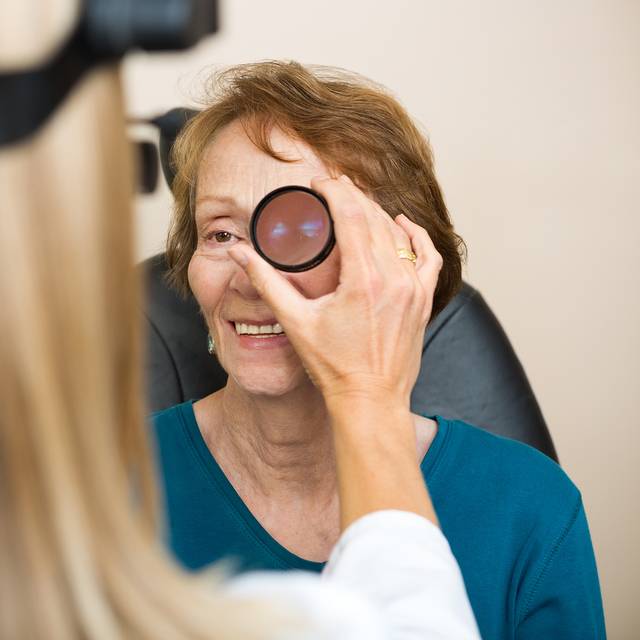Cataracts prevent clear images from appearing on the eye’s retina; causing mild, moderate, even severe blurred vision.
Typically an eye disorder associated with aging (over half of the people in America over age 80 have either had a cataract or cataract surgery), cataracts generally occur later in life as the lens structure within the human eye changes and gets older.
During the evaluation of your eye health, we will carefully examine your lens for signs of cataract formation. If a cataract is noticed and the clouding is causing visual disruption, the optometrist will refer you to a trusted and respected surgeon for surgery, which is the only known cure for cataracts. Our Eye Care Practice will be there for you providing pre and post cataract surgery care.

Symptoms of Cataracts
Maybe you have noticed your vision getting a little blurry? Sort of like looking through a smudged piece of glass or a cloudy lens? Have you noticed that when driving at night, the oncoming headlights seem bright or glaring? Do colors not appear as bright as they used to?
These are all symptoms of cataracts. There are different types of cataract and the type of cataract you have will affect the symptoms you experience.
Different Types of Cataracts
There is a type of cataract called a nuclear cataract that can actually bring about a temporary improvement in your near vision called ‘second sight’. Unfortunately, this effect doesn’t last long and will disappear as the cataract gets worse.
Another type of cataract is called a subcapsular cataract. A subcapsular cataract may produce no symptoms at all until it is nearly fully developed.
Cataracts can cause permanent damage to your eyes if they go untreated. The important thing is, that if you think you may have a cataract, contact your eye doctor as soon as possible and find out if you do.


Cataracts Treatment
Treatment for cataracts involves surgery, but being diagnosed with a cataract does not mean that you need to have surgery immediately, or maybe ever. You may be able to live with symptoms of early cataracts for a while by using vision aids such as glasses, anti-glare sunglasses, magnification lenses, strong bifocals or brighter lighting to suit your needs.
Surgery should be considered when the condition begins to seriously impair your vision to the extent that it affects your daily life such as reading or driving, playing golf, playing cards, watching TV, etc. Sometimes surgery is also necessary if the cataracts are preventing treatment of another eye problem.
The good news is that cataract surgery is typically very successful in restoring your vision. Together with your eye doctor, you will decide if and when the time for surgery has arrived.
Cataract Surgery
Cataract surgery is one of most common surgeries performed in North America and has a 90% success rate (meaning the patient has improved vision, between 20/20 and 20/40 vision, following the procedure).
Cataract surgery is the removal of the natural lens of the eye (also called "crystalline lens") that has developed an opacification, which is referred to as a cataract. Metabolic changes of the crystalline lens fibers over time lead to the development of the cataract and loss of transparency, causing impairment or loss of vision.
The surgery involves removing the clouded natural lens and usually replacing it with a clear, plastic intraocular lens (IOL) that becomes a permanent part of the eye. It is a relatively quick and painless procedure and you will not feel or see the IOL after the implant.
Following surgical removal of the natural lens, an artificial intraocular lens implant is inserted (eye surgeons say that the lens is "implanted"). Cataract surgery is generally performed by an ophthalmologist (eye surgeon) in an ambulatory (rather than inpatient) setting, in a surgical center or hospital, using local anesthesia (either topical, peribulbar or retrobulbar), usually causing little or no discomfort to the patient.
Day care, high volume, minimally invasive, small incision phacoemulsification with quick post-op recovery has become the standard of care in cataract surgery all over the world.


Preventing Cataracts
While development of cataracts is largely associated with age, there are other factors that can increase the risk of developing the condition. By knowing these risk factors, there are steps you can take to delay or prevent the development of cataracts:
- Sun Protection: Ultraviolet radiation can be a factor in the development of cataracts. It is recommended to protect your eyes from ultraviolet sunlight by wearing 100% UV protective sunglasses and a hat with a brim when you are exposed to the sun.
- Stop Smoking and Limit Alcohol Intake: These habits have been shown to increase the chances of developing cataracts, so if you smoke or regularly consume large amounts of alcohol – stop these habits.
- Proper Nutrition: Research shows that maintaining good health and nutrition can also reduce the risk of age-related cataracts, particularly by eating foods rich with vitamins A (beta-carotene), C and E and other antioxidants found in green leafy vegetables, fruit and a diet rich in Omega-3s.
- Regular Eye Exams: Once you reach the age of 50, or if you have diabetes or other eye conditions, it is important to have a comprehensive eye exam every year to check for signs of cataracts and other age-related eye conditions such as age-related macular degeneration or glaucoma. Early detection and treatment for many of these eye and vision disorders is often essential to save your vision.
